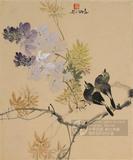元俞和篆隸千文 冊
推薦分享
資源連結
連結到原始資料 (您即將開啟新視窗離開本站)後設資料
- 資料識別:
- 故書000175N000000000
- 資料類型:
- 類型:書法
- 型式:文字
- 著作者:
- 俞和(Yu He)
- 出版者:
- 數位化執行單位:國立故宮博物院
- 日期:
- 元順帝至正十四年(1354)
- 格式:
- 本幅 21x24.7公分、全幅 28.6x32.1公分
- 語言:
- 漢文
- 關聯:
- 石渠寶笈三編(乾清宮),第二冊,頁527&*故宮書畫錄(卷三),第一冊,頁71&*俞和(活動於十四世紀中葉),字子中,號紫芝生。浙江杭州人。確切生生卒年不詳,至正二十三年(1363)尚在。性情安恬澹泊,隱居不仕。能詩,善書法,嘗遍臨晉唐諸名家書體,工力極深。早年得到趙孟頫(1254-1322)指授,頗得趙氏運筆之法,行草書逼似趙字,幾可亂真。 南朝梁武帝蕭衍(464-549)嘗指命周興嗣用一千個不同的字,編寫四字一句,運用對偶押韻的方式,以便於記憶朗誦,後來此千字文作為學童啟蒙的讀本,廣泛流傳。唐人重王羲之(303-361)書法,嘗以王字集成千字文帖。而歷代書家如隋釋智永、唐歐陽詢(557-641)、孫過庭、釋懷素(725-777?)等都有寫本或刻本傳世。受此流風影響,一直延續至元、明、清諸朝。其中,除了本幅外,如祝允明(1460-1526)、王寵(1494-1533)等明代吳派重要書家,亦皆有草書千字文藏於本院。 本幅〈篆隸千字文〉,共計三十七幅,凡二百九十五行,正文每行七字,以篆隸隔行分體書成。篆隸分行除了方便識讀外,兩相並陳同時也呈現了不同書體的美感,如圓筆的篆書,結體修長堅實,筆法瘦硬挺拔;另外,方筆的隸書,嚴謹整飭,筆鋒外露,挫力較重。&*俞和(1307-1382),字子中,號紫芝生,浙江杭州人。性安恬澹泊,能詩善書法,遍臨晉、唐諸家,功力極深。早年得趙孟頫(1254-1322)親授,故書法逼似趙字。本冊以篆、隸隔行並排書成,除了方便識讀外,也呈現了不同書體的美感。篆書的結體修長堅實,線條瘦硬挺拔,隸書結字方闊,用筆嚴謹整飭,風格優雅。&* Yu He (style name Zizhong, sobriquet Zizhi sheng) was a native of Hangzhou, Zhejiang. Leading a simple and tranquil life, he was also gifted at poetry and excelled at calligraphy, repeatedly copying the works of Jin and Tang dynasty masters to achieve thorough mastery. In his earlier years he was personally instructed by Zhao Mengfu (1254-1322), which is why his calligraphy is similar to Zhao’s. This album transcribes the “Thousand Character Classic” in alternating rows of seal and clerical script for the same passage, making it not only easier to decipher the individual characters, but it also reflecting the beauty of these different calligraphic script types. The character forms in seal script are elongated yet solid and the lines slender yet powerful. The characters in clerical script are broad and angular, the brushwork regulated and neat as well as refined and elegant in style.&*1.〈元俞和篆隸千字文〉,收入何傳馨、陳階晉、侯怡利主編,《五體千字文選輯》(臺北:國立故宮博物院,2010年六月出版一刷),頁73。 何炎泉,〈千字文概論〉,收入何傳馨、陳階晉、侯怡利主編,《五體千字文選輯》(臺北:國立故宮博物院,2010年六月出版一刷),頁176-188。 &*俞和(1307-1383),字子中,號紫芝生,浙江杭州人。性安恬澹泊,能詩善書法,遍臨晉、唐諸家,功力極深。早年得趙孟頫(1254-1322)親授,故書法逼似趙字。本冊以篆、隸隔行並排書成,除了方便識讀外,也呈現了不同書體的美感。篆書的結體修長堅實,線條瘦硬挺拔,隸書結字方闊,用筆嚴謹整飭,風格優雅。(20110913)&*Yu He (style name Zizhong, sobriquet Zizhi sheng) was a native of Hangzhou, Zhejiang. Leading a simple and tranquil life, he was also gifted at poetry and excelled at calligraphy, repeatedly copying the works of Jin and Tang dynasty masters to achieve thorough mastery. In his earlier years, he was personally instructed by Zhao Mengfu (1254-1322), which is why his calligraphy is similar to Zhao’s. This album transcribes the “Thousand Character Classic” in alternating rows of seal and clerical script for the same passage, making it not only easier to decipher the individual characters but also reflecting the beauty of these different calligraphic script types. The character forms in seal script are elongated yet solid and the lines slender yet powerful. The characters in clerical script are broad and angular, the brushwork regulated and neat as well as refined and elegant in style.(20110913)
- 管理權:
- 國立故宮博物院
授權聯絡窗口
- 國立故宮博物院圖像授權、出版授權、影音資料授權-申請流程說明
http://www.npm.gov.tw/zh-TW/Article.aspx?sNo=03003061






